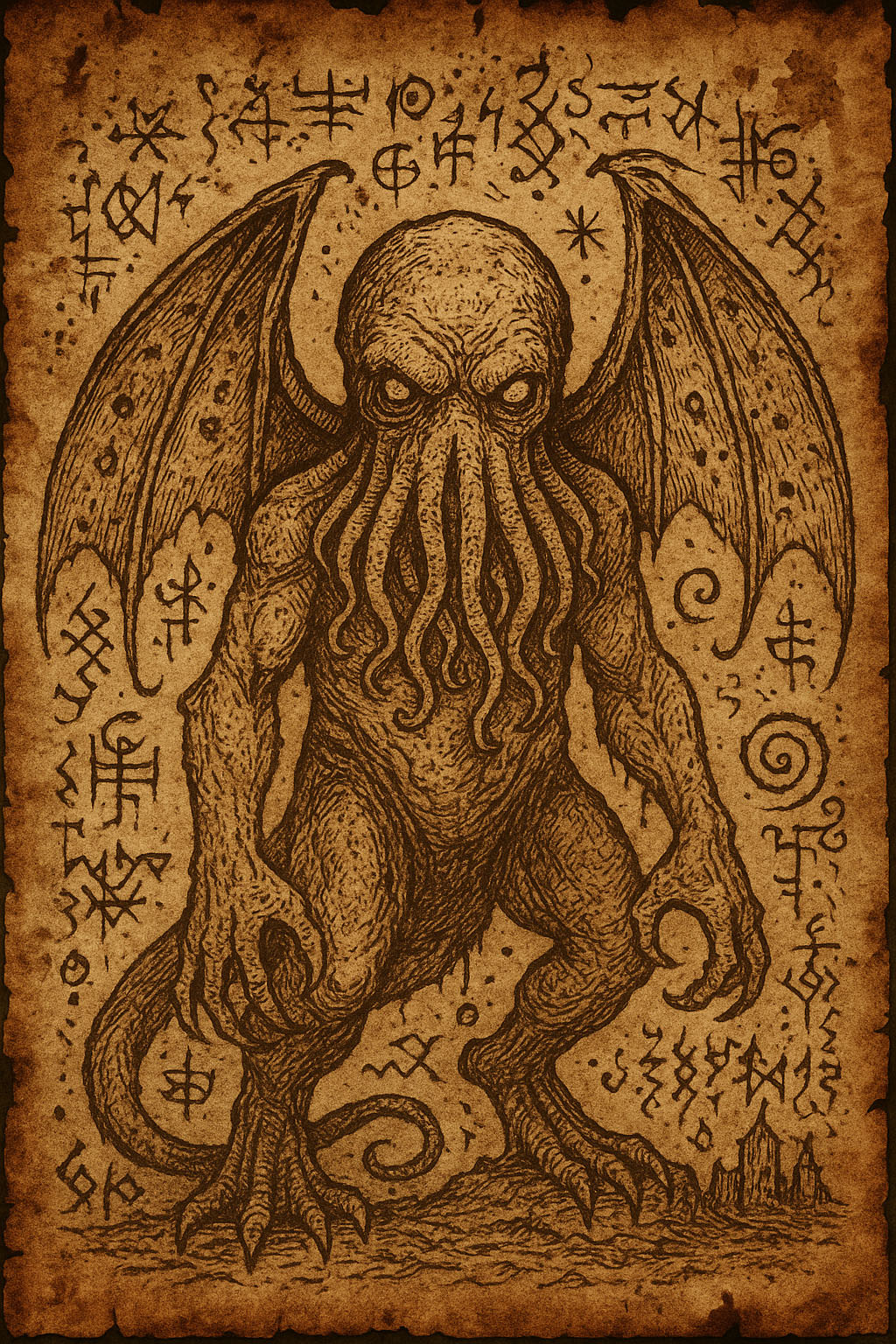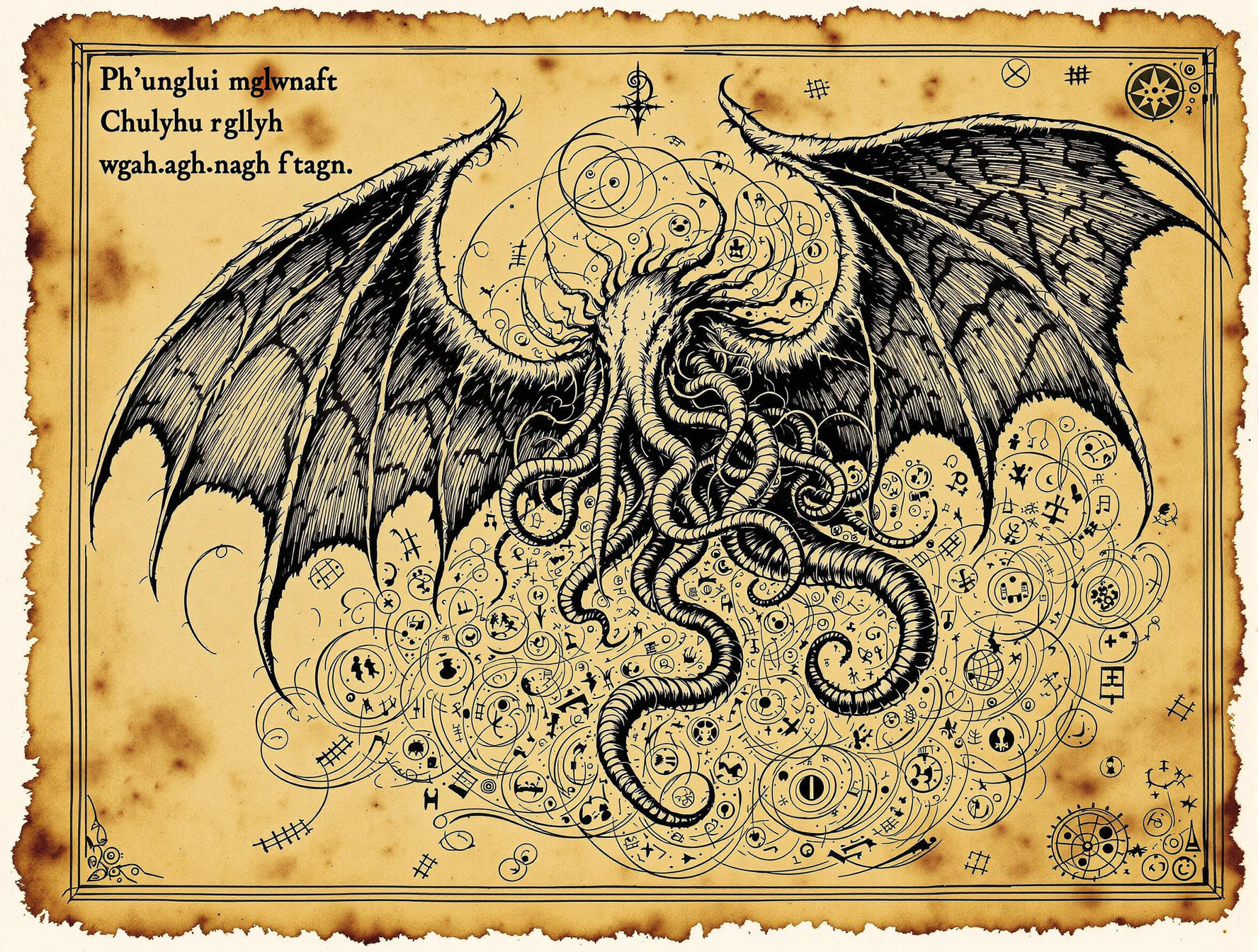In the abyssal darkness of the ocean, where light surrenders and time warps, something still breathes. It does not live. It does not die. It sleeps. And dreams. And in its dreams, we are there.
The Awakening of the Myth
The first time we hear of Cthulhu is in H.P. Lovecraft’s short story The Call of Cthulhu (1928). But the echo of that name—unpronounceable, gurgling, ancient—feels as though it predates even the story.
Cthulhu is not a monster. Not a god in any traditional sense. It is an idea. A whisper threading through the human psyche since time immemorial. A sleeping deity, buried in the submerged city of R’lyeh, waiting for the stars to align so it may rise again. And when it does, Lovecraft tells us, humanity will go insane at the mere contact with its truth.
Cthulhu, the Unnamable
How do you describe the indescribable? Tentacles that slither like thoughts, a cyclopean body part octopus, part dragon, membranous wings, and a face that seeps into dreams.
Lovecraft gives us only fragments, because the essence of Cthulhu is chaos, formlessness, alien vastness. The horror comes not from what Cthulhu does, but from what it is: a primordial intelligence, cosmically indifferent, so immense that the human mind fractures upon confronting it.
This is the core of cosmic horror: we are not the center of anything. We are not destined for anything. And if something greater does exist—it neither loves nor sees us.

Abyssal Archetypes
Strangely, entities similar to Cthulhu appear across distant cultures. The Leviathan in the Bible. Cipactli, the Aztec primeval monster. Tiamat, Mesopotamian sea goddess. The Norse Kraken.
All linked to the sea, chaos, and the pre-human era. Lovecraft, perhaps unconsciously, forged a modern archetype rooted in collective memory: fear of the unknown beneath the surface—both literal and psychological.
The ocean becomes a metaphor for the Freudian and Jungian unconscious, and R’lyeh a symbol of what we have forgotten... but which has not forgotten us.
The Origins of a Nightmare – What Inspired H.P. Lovecraft?
Where did Cthulhu come from? Which dreams, fears, or books fermented inside Lovecraft until they birthed the most iconic monster of the 20th century? While no single answer exists, we can draw a chilling mosaic of influences:
Dreams and Nightmares
Lovecraft himself said Cthulhu came to him in a vivid dream. He was obsessed with dreams, and many stories occur in dreamlike dimensions. Twisted geometry, shifting time, terror woven into tiny details—hallmarks of the dream-state.
Fear of the Other
Lovecraft harbored anxieties about everything “other”: foreign cultures, non-Western religions, lost civilizations. This worldview—now rightly criticized—shaped his fiction. R’lyeh is exotic and alien, its cultists from distant shores. Cthulhu is that which should not be.
Myth, Literature, and the Occult
Lovecraft was influenced by Poe, Dunsany, and Machen, but also by ancient myths. Dagon, Typhon, and pre-Biblical sea gods echo in his work. Cthulhu is a modern synthesis of ancient fears.
Science as Terror
Modern physics—relativity, a growing universe—did not comfort Lovecraft. Instead, it revealed a terrifying cosmic insignificance. Cthulhu reflects this: a being born not of faith, but of scientific awe and existential dread.
Visual and Tribal Art
The tentacles may draw from Japanese Ukiyo-e prints or from tribal Oceanic masks Lovecraft saw in magazines. A hybrid image to embody the indescribable.
Impossible Geometry and the Science of Terror
Lovecraft mentioned non-Euclidean geometry—today, we know it exists: hyperbolic geometry, fractals, topological spaces. R’lyeh might reside in four-dimensional space, visible only under certain mental or quantum conditions.
And what if Cthulhu is not a biological creature but an extradimensional consciousness? A mind so vast it spills beyond our spacetime?
Some physicists jokingly call dark matter “the Cthulhu of the cosmos”—invisible, dominant, unknowable. A wild thought: what if the 95% of the universe we don’t understand isn’t just matter... but mind?
Pop Cthulhu – The Meme-God
Paradoxically, this god of terror is everywhere today: plush toys, mugs, video games, comic books.
Cthulhu appears in Metallica songs, South Park, Rick & Morty, even SpongeBob. This process is called "domestication of horror": we mock what frightens us to survive it.
But in doing so, we keep Cthulhu alive. The more we name it, the more we shape it. The more we ridicule it, the more we summon it.
Cthulhu's Philosophy – The Atheist God
Lovecraft was an atheist and rationalist. But the universe he created is darker than one without a god—it’s a universe with something out there... and it doesn't care.
Not benevolent, not evil—just utterly alien. Cthulhu represents existential dread in a post-religious world: we are meaningless specks in a cold, vast cosmos.
This is the inversion of divinity: the gods of old judged and punished. Cthulhu sleeps. And in its sleep, it reminds us: indifference is more terrifying than evil.
The Dream Never Ends
“Ph’nglui mglw’nafh Cthulhu R’lyeh wgah’nagl fhtagn.”
In his house at R’lyeh, Cthulhu waits dreaming.
But what if we are not dreaming of him?
What if we are in his dream?
As long as humans ponder meaning, death, and the stars, Cthulhu will live on—not as a monster, but as a symbol.
A symbol of what we don’t understand.
Of what we fear.
And of what, in the end, we might secretly long to glimpse... even if it drives us mad.








Leave a Comment